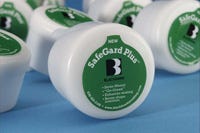Plastics closure molder Blackhawk Molding’s (Addison, IL) decision to switch from 100% low density polyethylene to a compound containing calcium carbonate (CaCO3) proved a solid one, as the change has helped the processor lower its costs and raise its productivity as it better markets its environmental credentials.
April 24, 2009
Plastics closure molder Blackhawk Molding’s (Addison, IL) decision to switch from 100% low density polyethylene to a compound containing calcium carbonate (CaCO3) proved a solid one, as the change has helped the processor lower its costs and raise its productivity as it better markets its environmental credentials. Dale Berg, general manager at Blackhawk Molding, says the transition to compounds containing a calcium carbonate additive called PolyMax from Heritage Plastics (Picayune, MS) has proven so successful that the company already has begun using the material in all three of its U.S. facilities and this year will introduce closures molded from the compounds to its European customers, served from its processing facility in England.
|
Blackhawk’s market is beverage closures, especially for the dairy and bottled water industry; it claims a 60% market share of caps for five-gallon water bottles. Adding CaCO3 to those caps helped improve the closures’ stiffness and product integrity, reports the molder, while also changing the matrix material’s heat profile so that it heats and cools more quickly, leading to faster cycle times. Electricity consumption per 1000 closures also drops as a result, as does the use of petroleum-based LDPE, leading to the molder’s improved “green” profile. This last cannot be discounted, especially in the water and dairy markets where “natural” is such a strong selling point.
Blackhawk also claims a 20-25% share of the market for molded milk jug closures and says the PolyMax-loaded compounds now used in its 38-mm milk jug caps has helped increase the resistance to cracking, and enabled the molder to halt its purchases of white pigments; the CaCO3 loading takes care of white coloration. According to Berg, the payoffs include at least 10% improvement in cycle time. —[email protected]
About the Author(s)
You May Also Like



